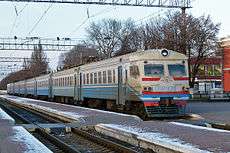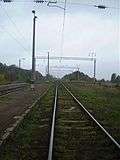| Ovruch to Chernihiv Line |
Legend |
|
|
The Chernihiv–Ovruch railway is a partially electrified[1] single track rail that connected the town of Ovruch and the city of Chernihiv, in northern Ukraine, passing through southern Belarus and the Chernobyl Exclusion Zone.
History
Line's construction started in 1928, as part of modernization and development program of the Southwestern Railways (Ukrainian: Південно-Західна залізниця). It was opened, for passenger traffic, in 1930.[2][3] Partially abandoned after the Chernobyl disaster of 1986, it works in its eastern section, between Chernihiv and Semikhody, a terminus station near Pripyat serving the Chernobyl Nuclear Power Plant. This line section was electrified in 1988.[4][5]
Route
Chernihiv-Slavutych-Pripyat
The line starts at the central station of Chernihiv, capital of the homonym oblast, located on Minsk-Gomel-Kiev line. After 2 minor stops within the city, it passes through some villages of Chernihiv Raion. At Zhukotki station started a (now closed) branch to Karkhivka and Zhidinichi. 36 km after Chernihiv the line reaches Slavutych, a city built in 1986 for the refugees from Pripyat and Chernobyl. Its station replaced the pre-existing "Nerafa", demolished to build a larger station for the new city.[6]
After the stops of Poselok Lesnoi, in Slavutych, and Nedanchychi, in Ripky Raion, the line enters in Belarus, in the Oblast of Gomel, passing on the Dnieper river. The station of Iolcha is the only one working, on the line, in Belarusian territory. It serves the villages of Staraya Iolcha, Novaya Iolcha, Krasnoe, and the near town of Komarin, all in Brahin Raion. After Iolcha, the line enters in the Polesie State Radioecological Reserve, created to enclose the territory of Belarus most affected by radioactive fallout from the Chernobyl accident, through three abandoned stations.
The first one, Kaporenka, was the interchange point (in Russian: Пересадочная, "Peresadochnaya")[7] of an abandoned siding to a decontamination park.
The line enters again in Ukraine, joining Ivankiv Raion, in Kiev Oblast, and the Exclusion Zone. After Zimovishche it passes on Pripyat River and a branch to the new Semikhody terminal station.[8] Built in 1988, is a terminus that substitutes Semikhody stop, on the main line, and the endpoint of the electfication and passenger service. Located in front of the nuclear plant, close to the New Safe Confinement, serves plant's workers and is the only working station of Pripyat.[9][10]
Continuing on the main line, it is a first industrial siding for the Chernobyl Plant and, after the so-called Bridge of Death, a second siding, just before Yaniv, the main station of Pripyat. The industrial line, which runs a loop around the nuclear plant passing between the 4 reactors and next to the cooling pond, is partially active because it allows goods and materials to be moved around the plant.[9]
Pripyat-Vilcha-Ovruch
Yaniv station, located between the homonym village and the southern suburb of Pripyat, was an important passenger hub before the nuclear accident. It is the nearest station to Chernobyl town, located 18 km south, town, and nowadays is a railroad graveyard, with a high number of abandoned trains, and one of the tourist sights of Pripyat. The station, refurbished in the 2010s, is used by workers of the society "Chornobylservis" (Ukrainian: Чорнобильсервіс)[8] for fixing heavy machinery.[11][12][13]
After leaving Pripyat, the line continues in a forested area, highly contaminated in several points. It is rarely used by freight trains serving the nuclear plant and passes several villages as Buriakivka, known for its large vehicle graveyard, full of abandoned radioactive machineries.[14] After Tovstyi Lis the line runs along the border between the "10-km" and "30-km" zones and enters Poliske Raion. It reaches the ghost town of Vilcha, 17 km north of Poliske, today one of the checkpoints to the Exclusion Zone. This section of the line is the most abandoned, with the track invaded by vegetation and the station buildings mostly in ruins.[10][15]
Leaving Vilcha, the line enters in Narodychi Raion of Zhytomyr Oblast; and after Racha (or Radcha), the line reaches Ovruch Raion. It crosses several villages and ends at Ovruch station, on the line linking Mazyr to Korosten. The Vilcha-Ovruch section, de jure operating but de facto abandoned, has no passenger services since 1986; and Vilcha station was still opened until 2013.[10][16][17]
Train services
Until 1986 the entire line was served by regional and long-distance trains, as the Moscow-Khmelnytskyi express service.[3][11] Current passenger services includes the following trains:
Popular culture
Ovruch station was mentioned in the book The Truce (Italian: La tregua, 1963), by the Italian writer Primo Levi. It was a stop on his crooked way home from Auschwitz concentration camp to Turin, in 1945.[18][19][20]
Gallery
| An ER9T, used on the line, at Chernihiv |
| Chernihiv Pidusivka station |
|
| Poselok Lesnoi station, near Slavutych |
|
| Rail bridge in Chernobyl Plant, part of the industrial branch from Yaniv station |
|
| A rail track nearby Vilcha station |
|
See also
References
External links
|
|---|
|
|
|
| People | | |
|---|
|
| Places | |
|---|
|
| Works | |
|---|
|
| Organisations | |
|---|
|
| Related articles | |
|---|
|
|









